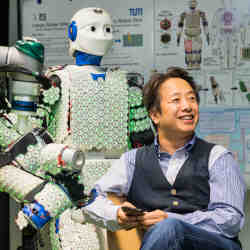
A team of roboticists at the Technical University of Munich (TUM) in Germany has demonstrated a versatile artificial skin that allows different robots to perform a variety of unique tasks.
In a recently published paper, the group, led by roboticist Gordon Cheng, details how robots draped in this electronic skin can grasp precariously balanced balls and even safely embrace a human. Demonstrating the hug was no mere gimmick. "When you're hugging another person, you require so many contact points to keep yourself safe and the other person safe," Cheng explains. "Most robots do not have that level of sense of touch."
As autonomous robots begin to work alongside people in factories, homes, and healthcare environments, electronic skin could help robots handle delicate items, avoid bumping into people and things, and more. This is not a new idea. Researchers have been working on electronic skin for decades, but experts say that improvements in computational power, electronics, sensor technology, and materials science have sparked recent advances.
Engineers are borrowing nature's tricks as well. For example, a bio-inspired e-skin developed at Johns Hopkins University stacks layers of sensor-filled electronic fabrics on top of one another. This e-dermis is more like human skin, with sensors both at the surface and buried beneath, than a simple two-dimensional patch.
Still, the current artificial versions hardly match the capabilities of human skin. "We kind of take our skin for granted," says University of North Carolina at Chapel Hill materials scientist Sergei Sheiko. "The mechanical performance or behavior of human skin is very unique. If you touch it, it's very soft, but if you pull the skin, you feel it's actually very stiff, and becomes nearly unbreakable. The material we use for soft robots should be soft but also firm, and difficult to break, like our own skin. But combining all these contrasting properties in one material is extremely challenging."
Sheiko and his group have made advances toward developing an artificial skin that is both soft and strong. In other research, Stanford University chemical engineer Zhenan Bao and her collaborators demonstrated the potential impact of their own sensitive, flexible electronic skin. As one example, a robot finger equipped with their e-skin, which can sense the direction of an applied force, not just its presence, delicately touched a raspberry and left it undamaged. The same robotic manipulator without the skin completely crushed the fruit.
Now that scientists can construct artificial skin with multiple sensors, Bao says, one of the main challenges is what to do with all the data gathered. The control systems in autonomous robots run on feedback loops driven by sensing, processing, and action. "If the computation is not fast enough," explains Bao, "then even if we can build a high-density e-skin, the robot will not be able to take advantage of all the data."
Cheng's group at TUM addressed this challenge by developing a novel bio-inspired means of reducing the compute load. In one instance, they wrapped their electronic skin around the arms, legs, and torso of a humanoid; 1,260 hexagonal cells in total. Each cell includes sensors that measure pressure, temperature, acceleration, and proximity. Together, these sensors help the robot sense contact and heat, track how it moves in three-dimensional space, and more. The use of different sensors isn't novel; the core technology was developed nearly a decade ago.
"The big breakthrough is doing all the computation onboard," says Cheng. "If you tried this using conventional methods, you'd need a room full of computers. What we did was compute the way human skin works, only processing information when you need it."
Sensor data is relayed only when there is a change, such as the pressure of a person's touch against the robot's forearm. When nothing novel happens, the sensors effectively stay out of the feedback loop. Cheng says this approach reduces the processing load by up to 90%, and it allows robots draped in his e-skin to accomplish some impressive tasks. In addition to delivering hugs, the humanoid was able to stand on one leg, because the pressure-sensitive cells on the soles of its feet improved its ability to sense its own center of mass.
Whether future robots are helping the elderly in their homes, picking delicate fruits from grocery store shelves, or working alongside people in factories, they likely will have some version of artificial skin to help them move and interact safely and intelligently. "If you're going to have a robot that is close to humans," Cheng says, "having sensitive skin will be extremely advantageous."
Gregory Mone is a science writer based in Boston, MA, USA, and the author, with Bill Nye, of Jack and the Geniuses: At the Bottom of the World.



Join the Discussion (0)
Become a Member or Sign In to Post a Comment